|
Wavetek
(Fluke) 395 100 MS/s
Synthesized
Universal
Waveform
Generator
w/option
001 & 002
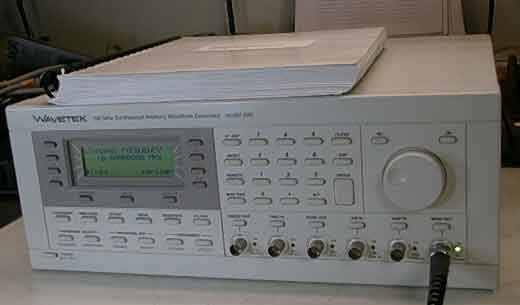
The Fluke / Wavetek
100 MS/s Synthesized Universal Waveform Generator
is a really great product. It has it all; outstanding
capabilities, specifications and most important "ease of use." The
unit is in excellent physical and electrical condition and includes a
comprehensive manual.
Fluke's 395 Universal Waveform Generator provides the functionality of
seven instruments for the price of one. You can use it as an arb, pulse
generator, function generator, noise generator, sweep generator, trigger
generator, or modulation source. Whatever the mix of your applications, the
395 is the best price/performance choice.
The latest digital technology, coupled with Fluke's innovative design,
means that the 395 can provide the functionality of seven instruments for
the price of one. The 100 MS/s 395 has the power and flexibility to provide
the right signals for applications ranging from in-circuit testing of
semiconductors to the complex pulse patterns required in communication
testing. And no other waveform generator provides such an easy and low-cost
solution to performance characterization testing of all kinds of electronic
devices.
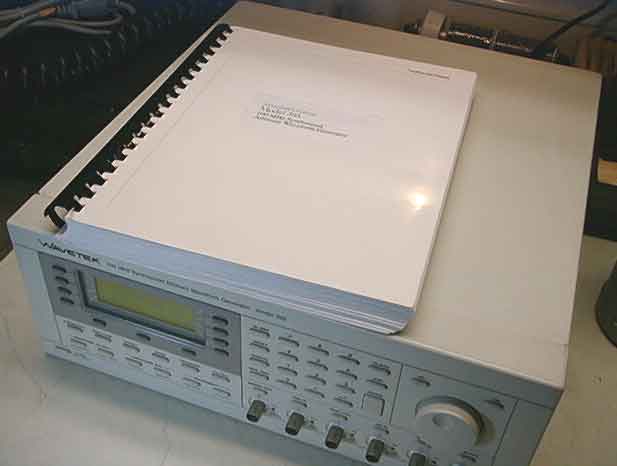
Includes
Option 001 -
IEEE-488
Interface
Option 002 -
256K Extended Memory
- Universal signal source
- High-speed performance
- 100 MS/s sampling clock
- 12-Bit vertical resolution
- 16 Standard functions
- Pulse train generator
- Noise generator
- Function generator including:
- Sine waves to 40 MHz
- Square waves to 50 MHz
- Triangle waves to 10 MHz
- Internal/external AM and internal FM modulation
- Sweep, trigger, and gate operation
- Waveform linking and summing
- Compatible with Wave Form DSP2
- SCPI compatible
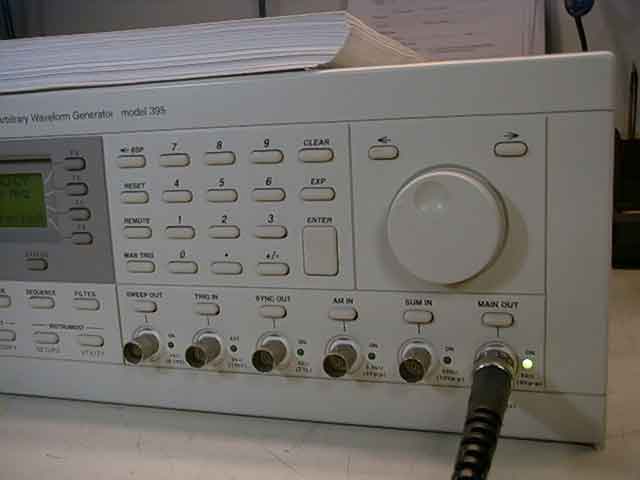
Arbitrary waveform
generator
The 395 takes its place in the impressive Fluke family of synthesized
arbitrary waveform generators as the worldwide price/performance leader
among single-channel arbs. There simply isn't another 100 MS/s arb on the
market that can match its price, especially when you consider the supporting
features. User-defined (arbitrary) waveforms can be generated at clock rates
from 100 mS/s to 100 MS/s with 12 bits of vertical resolution and 64k (256k
optional) points of horizontal memory. Direct Digital Synthesis (DDS)
techniques are used to provide accuracies comparable to those available in
expensive frequency synthesizers.
A waveform sequencing feature allows up to four waveforms to be linked
in a sequence for creating long waveforms.
Arbitrary waveforms can be created from the front panel or remotely
downloaded via the RS-232 interface (an RS-232 cable is included with the
395) or optional GPIB interface. The GPIB option includes direct DSO
waveform transfer, which allows you to upload waveforms directly into the
395 that have been captured with any of 25 different digital storage
oscilloscopes from a variety of vendors. Fluke also offers Wave Form DSP2, a
software tool that makes waveform creation, modification, and downloading
easy over either interface.
These are the kinds of high-performance specifications that make the
395 the arb of choice for a variety of applications that require complex,
nonstandard waveforms from simulating power line disturbances such as drop
out and spiked signals to providing complex signals for pressure sensors
used in mechanical testing.
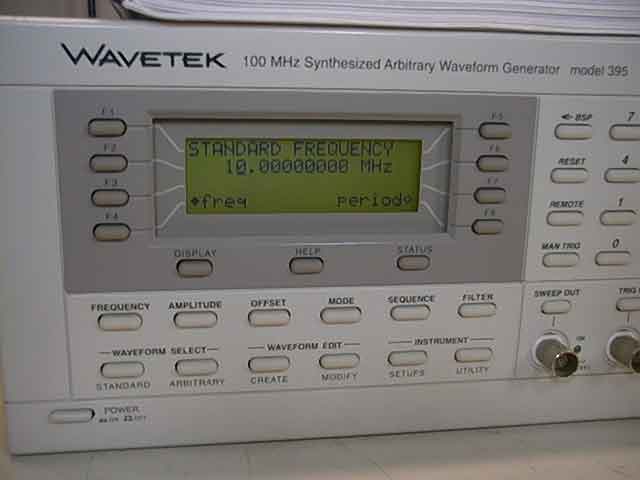
Function generator
With the introduction of the versatile and low-cost 395, there's no
longer any reason to buy an ordinary function-only generator. The 395
generates 16 standard waveforms: square, sine, positive and negative ramps,
pulse, pulse train, five different noise functions, triangle, positive and
negative haversines, (sin x)/x, and dc. And the performance specifications
are first rate, providing square waves to 50 MHz, sine waves to 40 MHz, and
triangles to 10 MHz, with synthesized accuracy and outputs up to 10 Vp-p
into 50W. Direct digital synthesis enables
10-digit frequency resolution for sine waves to 20 MHz and for most other
standard waveforms to 100 kHz. Waveforms can be output continuously or in
triggered, gated, or swept modes for applications like simulating input
signals to sensors. Other capabilities give you the flexibility of the very
best function generators including frequency and amplitude modulation, and
summing the 395's waveform with an external signal.
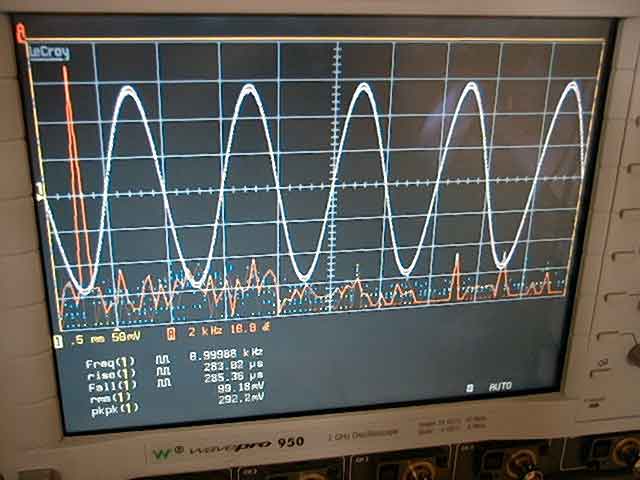
Noise
generator
The built-in noise generator is ideal for applications where precise
noise is required, such as testing electronic engine module noise
susceptibility in automobiles. Extensive noise generation capabilities are
provided by 5 programmable noise functions: analog (white) noise, digital
noise, comb function, signal-plus-noise, and signal-plus-comb. Other
programmable features include sequence length for white and digital noise,
bandwidths to 10 MHz for comb and white noise, bandwidths to 50 MHz for
digital noise, and noise-to-signal ratios from 1% to 99%.
Pulse
generator
The 395 has a built-in pulse generator that offers a greater degree of
control over pulse shape and amplitude than many other pulse generators.
Simple pulses up to 10 MHz can be generated. You can create complex pulse
trains of up to 10 pulses with individually programmable rise time, fall
time, width, level, and negative or positive delay (with respect to the sync
pulse). This versatility makes the 395 suitable in pulse applications as
diverse as measuring the baseband frequency response in a microwave system,
measuring the real-time impedance of biological cells, and testing
propagation delay in electronic circuits.
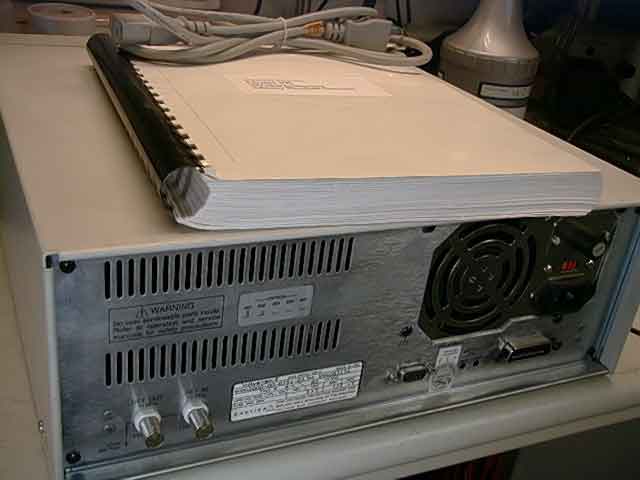
Trigger generator
The 395 makes a great trigger generator for devices under test, whether
you are using standard functions or user-defined waveforms.
Burst count is programmable from 1 to 1,048,575 cycles. Gated mode
provides continuous output of the waveform for the duration of the gating
signal. Four different trigger sources are available for maximum
versatility: internal trigger generator with programmable trigger period,
external signal with programmable trigger level and slope, remote trigger
command, and manual trigger key.
Sweep
generator
Use the 395 as a sweep generator for performance characterization and
frequency response testing, such as testing amplifier response or rapid
cycling of a mechanical servo. Standard or arbitrary waveforms can be swept
in one continuous range from 1 mHz to 20 MHz. Triggered and manual sweep
operations also can be performed. Seven sweep modes, with linear and
logarithmic sweep spacing, a TTL level sweep marker, and a ramp output give
you the flexibility you need. There's even a pen lift function for use with
chart recorders.
Modulation source
If you do communication or audio design and test, the 395 offers
internally generated amplitude modulation and frequency modulation, as well
as externally controlled amplitude modulation in two modes.
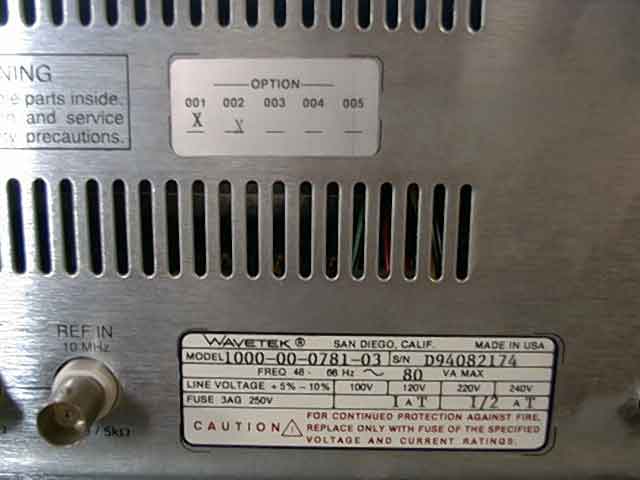
Convenience and Versatility
Fluke designed the 395 for user convenience. The user screens are
tailored to the particular jobs you want to perform, such as setting up a
pulse generator or a noise function.
From any screen, you can access help screens that guide you in using the
instrument's extensive capabilities. And you can store at least 10
instrument set-ups so you don't have to spend valuable time duplicating past
effort.
Low cost of ownership is assured by the high reliability and ease of
calibration of the 395. Calibration is performed with covers on in less than
15 minutes, under front panel or remote control.
|
Amplitude |
|
Range |
10 mVp-p
to 10 Vp-p into 50W |
|
Resolution |
3.0
digits |
|
Accuracy |
25 ±
10°C: ± (1% + 2 mVp-p) |
|
Offset |
|
Range |
± 5 V
into 50W |
|
Resolution |
3 digits |
|
Accuracy |
25 ±
10°C: ± (1% + 20 mV) |
|
Standard waveforms |
|
Standard waveforms |
Sine,
square, triangle, pulse, pulse trains, dc, positive/negative ramp,
positive/negative haversine, (sin x)/x, and five noise functions. |
Frequency
(Sine and Haversine) |
Range: 1 µHz to 40 MHz
Resolution: (Resolution limited by 1 µHz)
£ 20 MHz: 10 digits; ± 30 ppm
> 20 MHz: 4 digits; ± 100 ppm |
|
Frequency (Square) |
Range: 1 µHz to 50 MHz
Resolution: 4 digits; ± 100 ppm |
|
Frequency (Triangle) |
Range: 1 µHz to 10 MHz
Resolution:
£ 100 kHz: 10 digits; ± 30 ppm
> 100 kHz: 4 digits; ± 100 ppm |
|
Frequency (Ramp) |
Range: 1 µHz to 2 MHz
Resolution: ≤ 100 kHz: 10 digits; ± 30 ppm
> 100 kHz: 4 digits; ± 100 ppm |
Frequency
(Sin (x)/x) |
Range: 1 µHz to 1 MHz
Resolution:
² 100 kHz: 10 digits; ± 30 ppm
> 100 kHz: 4 digits; ± 100 ppm
|
|
Waveform quality |
Square transition time: < 8 ns
Square aberrations: < (5% + 20 mV)
Sine distortion:
< 100 kHz: 0.15% (-56 dBc)
< 5 MHz: No harmonic > -35 dBc |
|
Arbitrary waveforms |
|
Sampling frequency |
Range: 100 mS/s to 100 MS/s
Resolution: 4 digits
Accuracy: ± 100 ppm |
|
Waveform memory size |
64k
points; 256k points optional |
|
Minimum waveform size |
10
points |
|
Vertical resolution |
12 bits |
|
Output filters (selectable) |
20 MHz
Elliptic (8 pole), 40 MHz Elliptic (8 pole), 10 MHz Bessel (2 pole), no
filter |
|
Waveform sequencing |
Up to 4
waveforms can be linked. Each waveform can have a repeat (loop) count of
up to 65,535 or run continuously, conditional upon an external trigger
event (repeat until event true). Additionally, a sequence of waveforms
can be repeated up to 524,287 times or run continuously. |
|
Pulse waveforms |
|
Pulse
waveforms |
Up to 10
pulses may be independently programmed in a pulse pattern. Parameters
that can be independently programmed for each pulse are rise time, fall
time, width, delay, and amplitude. |
|
For
periods ≤655 µs |
Range: 100 ns to 655 µs
Resolution: 20 ns
Accuracy: ± 100 ppm
Rise/fall:
Fixed: 8 ns
Variable: 50 ns to 500 µs
Resolution: 8 ns
Accuracy: ± 0.1% ± 5 ns (< 8 ns for fixed rise/fall)
Delay: Range: -600 to +600 µs
Resolution: 10 ns
Accuracy: ± 0.1% ± 5 ns
Width:
Range: 10 ns to 655 µs
Resolution: 10 ns
Accuracy: ± 0.1% ± 5 ns
|
|
For
periods > 655 µs |
Range: 655 µs to 10s
Resolution: 4 digits
Accuracy: ± 100 ppm
Rise/Fall: 0.1% to 79% of period (or < 8 ns)
Delay: -99.9% to +99.9% of period
Width: 0.002% to 99.9% of period |
|
Noise |
|
White
(analog) noise |
Uniform
frequency distribution with programmable noise bandwidth.
Noise BW range: 10 mHz to 10 MHz
Sequence length:
Standard: 2n - 1, n = 6 to 16
With option 002: 2n - 1, n = 6 to 17 |
|
Digital noise |
Digital
noise provides a random 0,1 pattern with programmable sequence length.
Clock range: 10 mHz to 100 MHz
Sequence length:
Standard: 2n - 1, n = 6 to 16
With option 002: 2n - 1, n = 6 to 17 |
|
Comb |
Uniformly distributed frequency spectra within a well-defined frequency
band.
Start/Stop Range: 1 Hz to 10 MHz
Number of Lobes: 3 to 256 |
|
Signal-plus-noise, signal-plus-comb |
Adds
analog noise or comb to any standard or arbitrary waveform with precise,
controlled noise-to-signal ratio
N/S ratio: 1% to 99% Vp-p
Resolution: 1% |
|
Operational modes |
|
Continuous |
The
selected waveform is output continuously at the programmed frequency |
|
Gated |
The
selected waveform is output continuously at the programmed frequency
while the selected trigger signal is true |
|
Triggered |
Upon
transition of the selected trigger from false to true, the number of
cycles specified by the count is output at the specified frequency.
Burst count is programmable from 1 to 1,048,575. (One to 524,287 for
waveform sequence operation) |
|
Sweep |
Frequency sweep |
|
Triggering |
|
Trigger sources |
4
trigger sources. External TRIG IN BNC, internal trigger generator, front
panel manual trigger key, and remote trigger command |
|
Trigger level |
The
trigger level at the TRIG IN BNC is programmable |
|
Range |
-10V to
+10V |
|
Trigger slope |
Positive
or negative |
|
Internal trigger source |
Range: 200 ns to 1000s
Resolution: 100 ns limited by 6 digits |
|
Sync output |
|
Sync
output |
Sync
output can be selected from among the following 7 sources: waveform
sync, trigger signal, burst done, loop done, sweep marker, position
marker, pen lift. |
|
Internal frequency modulation |
|
Carrier signal |
Source: Sine Wave
Center frequency range: 0.01 Hz to 40 MHz
Deviation frequency range: 0.01 Hz to 40 MHz
Note: Center frequency plus deviation frequency must be ≤40 MHz. |
|
Modulating signal |
Source: Any waveform except noise, AM, FM, or pulse
Modulation frequency range: 0.01 Hz to 40 MHz |
|
Internal amplitude modulation |
|
Modes |
AM:
0 to 200% modulation
SCM: 200% modulation |
|
Carrier signal |
Source: Sine wave
Carrier frequency range: 0.01 Hz to 40 MHz |
|
Modulating signal |
Source: Any waveform except noise, AM, FM, or pulse
Modulation frequency range: 0.01 Hz to 40 MHz |
|
Signal summing |
|
Signal summing |
External
signals can be summed directly to the 395 output through the SUM IN BNC |
|
Sweep |
Standard
and arbitrary waveforms can be swept |
|
Sweep
start/stop |
Range: 1 mHz to 20 MHz
Resolution: 4 digits limited by 1 mHz |
|
Sweep
time |
Range: 30 ms to 1000s
Resolution: 1 ms |
|
Sweep
types |
Sweep
off, continuous, continuous with reverse, triggered, triggered with
reverse, triggered with hold, triggered with hold and reverse, and
manual. |
|
Sweep
spacing |
Linear
and logarithmic |
|
Outputs |
|
Reference output (50W) |
TTL
level into open circuit: > 1.2 Vp-p |
|
Main
output (50W) |
Output
may be selected on or off |
|
AM
input (2.5 kW) |
± 2.5V |
|
Sweep
output (1 kW) |
0 to 10V
ramp proportional to completion of sweep |
|
Sync
output (50W) |
Low
level: < 0.4 V into 50W
High level: > 2.0 V into 50W
Rise/fall time: < 7 ns |
|
Inputs |
|
Trigger input (2 kW) |
Level: ± 10V (programmable)
Maximum Frequency: 10 MHz |
|
Sum
input (600W) |
Level: ± 5 Vp-p max
Bandwidth: > 30 MHz
Protection: Over-voltage to ± 10 V |
|
Reference input (5 kW) |
Level: 1 Vp-p minimum, 10 Vp-p maximum; 50 Vdc maximum
Frequency: 10 MHz ± 5% |
|
General |
|
Remote operation |
RS-232
interface is standard. IEEE-488.2 (SCPI compatible) GPIB interface is
optional. |
|
Environment |
Designed
to MIL-T-28800C Class 5 |
|
Temperature range |
Operates
from 0° to +50°C: -20° to +70°C for storage |
|
Dimensions |
35.6 cm
(14.00 in) wide, 13.3 cm (5.22 in) high, and 39.4 cm (15.5 in) deep |
|
Weight |
Approximately 7.7 kg (17 lb) net; 10.0 kg (22 lb) shipping. |
|
Power |
90 to
132, 198 to 252 volts rms; 50/60 Hz; 1 phase; < 80 VA. |
|